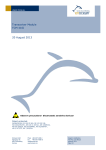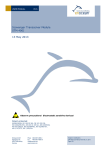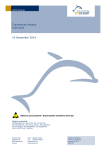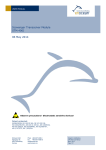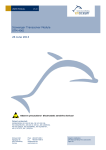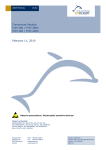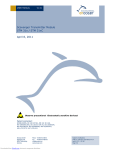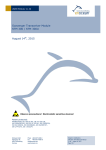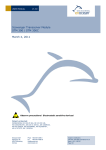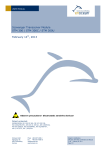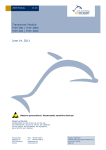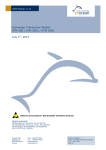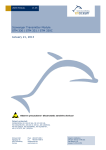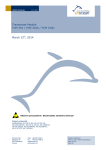Download 300 User Manual V0.82
Transcript
USER MANUAL V0.82 Scavenger Transceiver Module STM 300 / STM 300C February 11, 2010 Observe precautions! Electrostatic sensitive devices! Patent protected: WO98/36395, DE 100 25 561, DE 101 50 128, WO 2004/051591, DE 103 01 678 A1, DE 10309334, WO 04/109236, WO 05/096482, WO 02/095707, US 6,747,573, US 7,019,241 EnOcean GmbH Kolpingring 18a 82041 Oberhaching Germany Phone +49.89.67 34 689-0 Fax +49.89.67 34 689-50 [email protected] www.enocean.com Subject to modifications STM 300 / STM 300C User Manual V0.82 February 11, 2010 6:08 PM Page 1/32 USER MANUAL V0.82 STM 300 / STM 300C REVISION HISTORY The following major modifications and improvements have been made to the first version of this document: No 0.6 0.7 0.75 0.8 0.81 0.82 Major Changes Chapter 4 (Agency certifications) modified; Chapter 2.8.1 Order of Data Bytes for 10/8/6 bit option modified Drawing in 1.3 corrected; Chapter 3.4 and 3.5 modified. Charging circuit in chapter 3.1 modified Additional function on pin WXIDIO; charging circuit in chapter 3.1 modified; programmable delay time for measurement added in 2.8.2; operating temperature range limited to -25 °C/+85 °C; deep sleep current increased to 0.2 µA; RX sensitivity reduced to -94 dBm; Layout recommendation in 3.5 modified; Maximum Ratings (non-operating) modified in 2.4, Maximum Ratings (operating) added in 2.5 Section 2.7 and 2.11 modified. Max output currents in 2.3 reduced ECS 3x0 solar cells mentioned. Receive current increased to typ.33 mA; Section 2.7 and 2.3.2 modified; Section 3.4 inserted; recommended foot pattern added in 3.6; new drawing in 1.3; section 3.8 Tape&Reel spec added; RX sensitivity reduced to -93 dBm Sections 3.2.x content removed; section 4.2 and 4.3 content removed Max. ripple at VDD reduced to 50 mVpp; Connect external 1 kΩ pull-down to RESET and PROG_EN. Published by EnOcean GmbH, Kolpingring 18a, 82041 Oberhaching, Germany www.enocean.com, [email protected], phone ++49 (89) 6734 6890 © EnOcean GmbH All Rights Reserved Important! This information describes the type of component and shall not be considered as assured characteristics. No responsibility is assumed for possible omissions or inaccuracies. Circuitry and specifications are subject to change without notice. For the latest product specifications, refer to the EnOcean website: http://www.enocean.com. As far as patents or other rights of third parties are concerned, liability is only assumed for modules, not for the described applications, processes and circuits. EnOcean does not assume responsibility for use of modules described and limits its liability to the replacement of modules determined to be defective due to workmanship. Devices or systems containing RF components must meet the essential requirements of the local legal authorities. The modules must not be used in any relation with equipment that supports, directly or indirectly, human health or life or with applications that can result in danger for people, animals or real value. Components of the modules are considered and should be disposed of as hazardous waste. Local government regulations are to be observed. Packing: Please use the recycling operators known to you. By agreement we will take packing material back if it is sorted. You must bear the costs of transport. For packing material that is returned to us unsorted or that we are not obliged to accept, we shall have to invoice you for any costs incurred. © 2010 EnOcean | www.enocean.com STM 300 / STM 300C User Manual V0.82 | Page 2/32 USER MANUAL V0.82 STM 300 / STM 300C TABLE OF CONTENT 1 1.1 1.2 1.3 1.4 1.5 GENERAL DESCRIPTION ............................................................................... 4 Basic functionality ....................................................................................... 4 Technical data............................................................................................. 5 Physical dimensions ..................................................................................... 5 Environmental conditions.............................................................................. 6 Ordering Information ................................................................................... 6 2 FUNCTIONAL DESCRIPTION .......................................................................... 7 2.1 Simplified firmware flow chart and block diagram............................................. 7 2.2 Hardware pin out......................................................................................... 9 2.3 Pin description and operational characteristics ................................................. 9 2.3.1 Interface supply voltage ..........................................................................11 2.3.2 Analog and digital inputs .........................................................................11 2.4 Absolute maximum ratings (non operating)....................................................12 2.5 Maximum ratings (operating) .......................................................................12 2.6 Power management and voltage regulators ....................................................12 2.7 Charge control output (CCO)........................................................................13 2.8 Configuration .............................................................................................14 2.8.1 Configuration via pins .............................................................................14 2.8.2 Configuration via serial interface...............................................................15 2.9 Radio telegram ..........................................................................................16 2.9.1 Normal operation....................................................................................16 2.9.2 Teach-in telegram ..................................................................................17 2.10 Transmit timing.....................................................................................17 2.11 Energy consumption ..............................................................................18 3 APPLICATIONS INFORMATION ......................................................................19 3.1 How to connect an energy harvester and energy storage..................................19 3.2 Using the SCO pin ......................................................................................20 3.3 Using the WAKE pins...................................................................................20 3.4 Using RVDD...............................................................................................21 3.5 Antenna options .........................................................................................22 3.5.1 Overview...............................................................................................22 3.5.2 Whip antenna ........................................................................................23 3.5.3 Chip antenna: in preparation....................................................................24 3.5.4 Splatch antenna: in preparation................................................................24 3.5.5 Helical antenna: in preparation .................................................................24 3.6 Layout recommendations for foot pattern.......................................................25 3.7 Soldering information..................................................................................28 3.8 Tape & Reel specification .............................................................................29 3.9 Transmission range ....................................................................................30 4 AGENCY CERTIFICATIONS ...........................................................................31 4.1 CE Approval...............................................................................................31 4.2 FCC (United States) certification: in preparation .............................................32 4.3 IC (Industry Canada) certification: in preparation............................................32 © 2010 EnOcean | www.enocean.com STM 300 / STM 300C User Manual V0.82 | Page 3/32 USER MANUAL V0.82 STM 300 / STM 300C 1 GENERAL DESCRIPTION 1.1 Basic functionality The extremely power saving RF transmitter module STM 300 of EnOcean enables the realization of wireless and maintenance free sensors and actuators such as room operating panels, motion sensors or valve actuators for heating control. Power supply is provided by an external energy harvester, e.g. a small solar cell (e.g. EnOcean ECS 3x0) or a thermal harvester. An energy storage device can be connected externally to bridge periods with no supply from the energy harvester. A voltage limiter avoids damaging of the module when the supply from the energy harvester gets too high. The module provides a user configurable cyclic wake up. After wake up a radio telegram (input data, unique 32 bit sensor ID, checksum) will be transmitted in case of a change of any digital input value compared to the last sending or in case of a significant change of measured analogue values (different input sensitivities can be selected). In case of no relevant input change a redundant retransmission signal is sent after a user configurable number of wake-ups to announce all current values. In addition a wake up can be triggered externally. Features with built-in firmware 3 A/D converter inputs 4 digital inputs Configurable wake-up and transmission cycle Wake-up via Wake pins Voltage limiter Threshold detector Application notes for calculation of energy budgets and management of external energy storages Product variants STM 300/300C: SMD mountable module for use with external antenna (868/315 MHz) Features accessible via API Using the Dolphin API library it is possible to write custom firmware for the module. STM 300 / STM 300C is in-system programmable. The API provides: Integrated 16 MHz 8051 CPU with 32 KB FLASH and 2 kB SRAM Receiver functionality Various power down and sleep modes down to 0.2 µA current consumption Up to 16 configurable I/Os 10 bit ADC, 8 bit DAC © 2010 EnOcean | www.enocean.com STM 300 / STM 300C User Manual V0.82 | Page 4/32 USER MANUAL V0.82 STM 300 / STM 300C 1.2 Technical data Antenna Frequency Radio Standard Data rate/Modulation type Receiver Sensitivity (at 25°C) Conducted Output Power Power Supply Current Consumption Input Channels 4x digital input, 2x WAKE input , 3x analog input Resolution: 3x 8 bit or 1x 10 bit, 1x 8 bit, 1x 6 bit R&TTE EN 300 220 (STM 300) FCC CFR-47 Part 15 (STM 300C) Radio Regulations 1.3 External whip or 50 Ω antenna mountable 315.0 MHz (STM 300C)/868.3 MHz (STM 300) EnOcean 868 MHz/315 MHz 125 kbps/ASK typ. –93 dBm, receiver available only via API typ. 5 dBm 2.1 V–4.5 V, 2.5 V needed for start-up Deep Sleep mode : typ. 0.2 µA Transmit mode: typ. 24 mA, max. 33 mA Receive mode (available via API only): typ. 33 mA, max. 43 mA Physical dimensions PCB dimensions STM 300/STM 300C: 22x19x3.1 mm Unless otherwise specified dimensions are in mm. Tolerances: PCB outline dimensions ±0.2 mm All other tolerances ±0.1 mm STM 300 / STM 300C (pads on bottom side of PCB!) © 2010 EnOcean | www.enocean.com STM 300 / STM 300C User Manual V0.82 | Page 5/32 USER MANUAL V0.82 STM 300 / STM 300C 1.4 Environmental conditions Operating temperature -25 °C … +85 °C Storage temperature -40 °C … +85 °C Storage temperature in tape & reel package Humidity 1.5 0 °C … +40 °C 0% … 93% r.h., non-condensing Ordering Information Type STM 300 STM 300C Ordering Code S3001-D300 S3031-D300 Frequency 868.3 MHz 315.0 MHz Suited solar cells (for technical details please refer to the ECS3x0 data sheet): Type ECS 300 ECS 310 Ordering Code S3005-D305 S3005-D310 © 2010 EnOcean | www.enocean.com Size 35.0×12.8×1.1 mm 50.0×20.0×1.1 mm STM 300 / STM 300C User Manual V0.82 | Page 6/32 USER MANUAL V0.82 STM 300 / STM 300C 2 FUNCTIONAL DESCRIPTION 2.1 Simplified firmware flow chart and block diagram © 2010 EnOcean | www.enocean.com STM 300 / STM 300C User Manual V0.82 | Page 7/32 USER MANUAL V0.82 STM 300 / STM 300C RF_50 RF_WHIP VDD VDDLIM BALUN 16MHz Oscillator RF Transceiver DOLPHIN EO3000I V_OUT DVDD UVDD Micro Controller Spontaneous wake-up Presence Signal (every 1s ,10s , 100s, or SW defined) (every 100th, every 10th, every cyclic wake-up or SW defined) CP_0 1 A/D CP_1 26 DVDD VDD XTAL 16MHz VDDLIM GND IOVDD Antenna balun RSDADIO3 EO3000I RF_WHIP WSDADIO2 GND SCLKDIO1 RF_50 SCSEDIO0 STM300 – TOP VIEW 18 © 2010 EnOcean | www.enocean.com PROG_EN GND ADIO7 ADIO6 ADIO5 ADIO4 ADIO3 ADIO2 ADIO1 9 ADIO0 RVDD AD_0 AD_1 AD_2 GND WXIDIO WXODIO GND GND UVDD WAKE0 WAKE1 CCO GND DI_0 DI_1 DI_2 DI_3 LED IOVDD SCO Cyclic Wake-up RESET GND Digital Inputs RESET CW_1 CW_0 Power management GND WAKE0 LRN 868.3 MHz (STM300) 315.0 MHz (STM300C) STM 300 / STM 300C User Manual V0.82 | Page 8/32 USER MANUAL V0.82 STM 300 / STM 300C 2.2 Hardware pin out The figure above shows the pin out of the STM 300 hardware. The pins are named according to the naming of the EO3000I chip to simplify usage of the DOLPHIN API. The table in section 2.3 shows the translation of hardware pins to a naming the fits the functionality of the built-in firmware. 2.3 Pin description and operational characteristics STM 300 Hardware Symbol GND VDD STM 300 Firmware Symbol GND VDD RVDD V_OUT DVDD DVDD UVDD UVDD VDDLIM VDDLIM IOVDD IOVDD RESET RESET PROG_EN PROG_EN ADIO0 AD_0 ADIO1 AD_1 ADIO2 AD_2 ADIO3 DI_0 ADIO4 DI_1 ADIO5 DI_2 © 2010 EnOcean | www.enocean.com Function Characteristics Ground connection Must be connected to GND Supply voltage 2.1 V – 4.5 V; Start-up voltage: 2.5 V Maximum ripple: see 0 RF supply voltage 1.8 V. Output current: max. 10 mA. See 3.4! regulator output Supply for external circuitry, available while not in deep sleep mode. Digital supply volt- 1.8 V. Output current: max. 5 mA age regulator out- Supply for external circuitry, available put while not in deep sleep mode. Ultra low power Not for supply of external circuitry! For use with WAKE pins, see section 3.3. supply voltage regulator output Max. 1 µA output current! Supply voltage Limitation voltage: 4.5 V limiter input Maximum shunting current: 50 mA Digital interface Must be connected to desired interface supply voltage supply between 1.8 V and 3.3 V, e.g. to DVDD. See also 2.3.1 Reset input Active high reset (1.8 V) Programming I/F External 1 kΩ pull-down required! Programming I/F HIGH: programming mode active LOW: operating mode Digital input, external 1 kΩ pull-down required! Analog input Input read ~2 ms after wake-up. Resolution 8bit. See also 2.3.2. Analog input Input read ~2 ms after wake-up. Resolution 8bit (default) or 10 bit. See also 2.3.2. Analog input Input read ~2 ms after wake-up. Resolution 8 bit (default) or 6 bit. See also 2.3.2. Digital input Input read ~2 ms after wake-up. See also 2.3.2. Digital input Input read ~2 ms after wake-up. See also 2.3.2. Digital input Input read ~2 ms after wake-up. See also 2.3.2. STM 300 / STM 300C User Manual V0.82 | Page 9/32 USER MANUAL V0.82 STM 300 / STM 300C ADIO6 DI_3 Digital input ADIO7 LED Transmission indicator LED SCSEDIO0 CW_1 SCLKDIO1 CW_0 WSDADIO2 CP_1 RSDADIO3 CP_0 WXIDIO SCO Programming I/F Encoding input for wake-up cycle Programming I/F Encoding input for wake-up cycle Programming I/F Encoding input for retransmission Programming I/F Encoding input for retransmission Programming I/F Sensor control WXODIO CCO Charge control WAKE0 WAKE0 Wake input WAKE1 LRN LRN input RF_WHIP RF_50 RF_WHIP RF_50 RF output RF output © 2010 EnOcean | www.enocean.com Input read ~2 ms after wake-up. See also 2.3.2. Max. output current: 2 mA @ IOVDD=3.3 V 0.65 mA @ IOVDD=1.8 V Leave open or connect to GND Leave open or connect to GND Leave open or connect to GND Leave open or connect to GND Digital output, max. current 15 µA HIGH ~x ms before analog inputs are read (x=0…508 ms; default 2 ms.) LOW at wake-up and after reading of analog inputs Polarity can be inverted, delay time can be programmed, see 2.8.2. Max output current 15 µA See 2.7 for description of behaviour. Change of logic state leads to wake-up and transmission of a telegram. See also 3.3. Change of logic state to LOW leads to wake-up and transmission of teach-in telegram if a manufacturer code is programmed. See also 2.9.2 and 3.3. Output for whip antenna 50 Ohm output for external antenna STM 300 / STM 300C User Manual V0.82 | Page 10/32 USER MANUAL V0.82 STM 300 / STM 300C 2.3.1 Interface supply voltage For digital communication with other circuitry (peripherals) the digital I/O configured pins of the mixed signal sensor interface (ADIO0 to ADIO7) and the pins of the serial interface (SCSEDIO0, SCLKDIO1, WSDADIO2, RSDADIO3) may be operated from supply voltages different from DVDD. Therefore an interface supply voltage pin IOVDD is available which can be connected either to DVDD or to an external supply within the tolerated voltage range of IOVDD. Please note that the wristwatch XTAL I/Os WXIDIO and WXODIO are always supplied from UVDD. If DVDD=0V (e.g. in any sleepmode) and IOVDD is supplied, there may be unpredictable and varying current from IOVDD caused by internal floating nodes. It must be taken care that the current into IOVDD does not exceed 10 mA while DVDD=0V. If DVDD=0V and IOVDD is not supplied, do not apply voltage to any above mentioned pin. This may lead to unpredictable malfunction of the device. IOVDD voltage must not exceed VDD voltage! A malfunction of the module may be caused by such inverse supply! For I/O pins configured as analog pins the IOVDD voltage level is not relevant! 2.3.2 Analog and digital inputs Parameter Analog Input Measurement range Conditions / Notes Min Single ended Input coupling Measurement bandwidth Input resistance Typ 0.05 RVDD0.05 DC 100 Single ended against RGND @ 1 kHz Input capacitance Single ended against RGND @ 1 kHz Effective measurement resolution Configurable, see 2.8.2 Related to the reference Relative measurement accuracy voltage within specified input range Digital Input Mode 10 6 © 2010 EnOcean | www.enocean.com 90 38 V 10 pF 10 0.6 bit % V Input LOW voltage @IOVDD=1.7 … 1.9 V @IOVDD=3.0 … 3.6 V Units kHz MΩ 2/3 IOVDD Input HIGH voltage Pull up resistor Max 132 54 1/3 IOVDD 200 85 V kΩ kΩ STM 300 / STM 300C User Manual V0.82 | Page 11/32 USER MANUAL V0.82 STM 300 / STM 300C 2.4 Absolute maximum ratings (non operating) Symbol Parameter VDD Supply voltage at VDD and VDDLIM VDDLIM Supply voltage for mixed signal sensor interface and IOVDD serial interface pins GND Ground connection VINA Voltage at every analog input pin Voltage at RESET, WAKE0/1, and every digital input VIND1 pin except WXIDIO/WXODIO VIND2 Voltage at WXIDIO / WXODIO input pin 2.5 Min -0.5 Max 5.5 -0.5 3.6 V 0 -0.5 -0.5 0 2 3.6 V V V -0.5 2 V Maximum ratings (operating) Symbol Parameter VDD Supply voltage at VDD and VDDLIM VDDLIM Min VOFF Max 4.5 1.7 IOVDD Digital interface supply voltage (see also 2.3.1) GND VINA Ground connection Voltage at every analog input pin Voltage at RESET, WAKE0/1, and every digital input pin except WXIDIO / WXODIO Voltage at WXIDIO / WXODIO input pin VIND1 VIND2 2.6 Units V Units V V 0 0 0 MIN (3.6; VDD) 0 2.0 3.6 0 2.0 V V V V Power management and voltage regulators Symbol Parameter Conditions / Notes Voltage Regulators Ripple on VDD, where VDDR Min(VDD) > VON UVDD Ultra Low Power supply RVDD RF supply DVDD Digital supply Voltage Limiter VLIM Limitation voltage ILIM Shunting current Threshold Detector VON Turn on threshold Automatic shutdown if VOFF Turn off threshold VDD drops below VOFF © 2010 EnOcean | www.enocean.com Min 1.7 1.7 Typ 1.8 1.8 1.8 Max Units 50 mVpp 1.9 1.9 V V V 50 V mA 2.6 2.1 V V 4.5 2.3 1.85 2.45 1.9 STM 300 / STM 300C User Manual V0.82 | Page 12/32 USER MANUAL V0.82 STM 300 / STM 300C Voltage Limiter STM 300 provides a voltage limiter which limits the supply voltage VDD of STM 300 to a value VDDLIM which is slightly below the maximum VDD ratings by shunting of sufficient current. Threshold detector STM 300 provides an ultra low power ON/OFF threshold detector. If VDD > VON, it turns on the ultra low power regulator (UVDD), the watchdog timer and the WAKE# pins circuitry. If VDD ≤ VOFF it initiates the automatic shut down of STM 300. 2.7 Charge control output (CCO) After startup STM 300 provides the output signal of the threshold detector at CCO. CCO is supplied by UVDD. The output value remains stable also when STM 300 is in deep sleep mode. Behavior of CCO - At power up: TRISTATE until VDD>VON then HIGH if VDD>VON then HIGH if VDD<VON then LOW if VDD< ~0.9 V TRISTATE until next power up VDD CCO VDD VDD > VON VDD < VON VON VDD < VOFF VOFF 1.8V ~0.9V High Impedance 0V High Impedance t For definition of VON and VOFF please refer to 2.6. © 2010 EnOcean | www.enocean.com STM 300 / STM 300C User Manual V0.82 | Page 13/32 USER MANUAL V0.82 STM 300 / STM 300C 2.8 Configuration 2.8.1 Configuration via pins The encoding input pins have to be left open or connected to GND in correspondence with the following connection schemes. These settings are checked at every wake-up. Wake-up cycle time CW_0 CW_1 Wake-up cycle time NC NC 1 s ±20% GND NC 10 s ±20% NC GND 100 s ±20% GND GND No cyclic wake-up Redundant retransmission Via CP_0 and CP_1 an internal counter is set which is decreased at every wake-up signal. Once the counter reaches zero the redundant retransmission signal is sent. CP_0 CP_1 NC NC Number of wake-ups that trigger a redundant retransmission Every timer wake-up signal GND NC Every 7th - 14th timer wake-up signal, affected at random NC GND Every 70th - 140th timer wake-up signal, affected at random GND GND No redundant retransmission A radio telegram is always transmitted after wake-up via WAKE pins! After transmission the counter is reset to a random value within the specified interval. According to FCC 15.231a) a redundant retransmission at every timer wake-up to determine the system integrity is only allowed in safety and security applications! In this case the total transmission time must not exceed two seconds per hour, which means that a combination with a 1 s wake-up cycle time is not allowed! If applied in other (non-safety, non-security) applications a minimum of 10 s between periodic transmissions is required. In addition the device has to comply with the lower field strength limits of 15.231e). The limited modular approval of STM 300C is not valid in this case. © 2010 EnOcean | www.enocean.com STM 300 / STM 300C User Manual V0.82 | Page 14/32 USER MANUAL V0.82 STM 300 / STM 300C 2.8.2 Configuration via serial interface Via the programming interface the configuration area can be modified. This provides a lot more configuration options. Values set via serial interface override hardware settings! These settings are read after RESET or power-on reset only and not at every wake-up of the module! Parameter Configuration via pins Configuration via serial interface Value can be set from 1 s to 65534 s Wake up cycle See section 2.8.1 Redundant Retransmission cycle See section 2.8.1 Min…Max values for random interval If Min=Max -> random switched off Threshold values for analog inputs No The default values are: 5 LSB at AD_1 input, 6 LSB at AD_0 and 14 LSB at AD_2. The threshold value can be set between 0 and full scale for every input individually. Resolution of the analog inputs No Default: AD_0: 8 bit, AD_1: 8 bit, AD_2: 8 bit Option: AD_0: 10 bit, AD_1: 6 bit, AD_2: 8 bit Input mask No A digital input mask for ignoring changes on digital input pins. At default all input bits are checked. Delay time between SCO on and sampling moment No Value can be set from 0 ms to 508 ms in steps of 2 ms. Default delay time is 2 ms. Source of AD_2 No Select if AD_2 contains measurement value of external ADIO2 pin or from internal VDD/4 Polarity of SCO signal No Polarity can be inversed. Edge of wake pin change causing a telegram transmission No Every change of a wake pin triggers a wake-up. For both wake pins it can be configured individually if a telegram shall be sent on rising, falling or both edges. Manufacturer ID and EEP No (EnOcean Equipment Profile) Information about manufacturer and type of device. This feature is needed for “automatic” interoperability of sensors and actuators or bus systems. Information how to set these parameters requires an agreement with EnOcean. Unique manufacturer IDs are distributed by the EnOcean Alliance. The interface is shown in the figure below: USB Dolphin Studio, or EOP USB <=> SPI interface SPI Reset PROG_EN ADIO7 SCSEDIO0 SCLKDIO1 WSDADIO2 RSDADIO3 STM 300 EnOcean provides EOPx (EnOcean Programmer, a command line program) and Dolphin Studio (Windows application for chip configuration, programming, and testing) and the USB/SPI programmer device as part of the EDK 300 developer´s kit. © 2010 EnOcean | www.enocean.com STM 300 / STM 300C User Manual V0.82 | Page 15/32 USER MANUAL V0.82 STM 300 / STM 300C 2.9 Radio telegram 2.9.1 Normal operation Telegram content (seen at serial interface of RCM 130/TCM 3x0 or at DOLPHIN API): ORG = 0x07 (Telegram type “4BS”) Data_Byte1..3 3x8bit mode: DATA_BYTE3 DATA_BYTE2 DATA_BYTE1 = Value of AD_2 analog input = Value of AD_1 analog input = Value of AD_0 analog input 1x8bit, 1x6it, 1x10bit mode: DATA_BYTE3 = Value of AD_2 DATA_BYTE2 = Upper 2 bits of AD_0 and value of AD_1 DATA_BYTE1 = Lower 8 bits Value of AD_0 analog input DATA_BYTE3 AD_2 7 6 5 4 3 2 1 0 5 DATA_BYTE2 DATA_BYTE1 AD_1 AD_0 4 3 2 1 0 9 8 7 6 5 4 3 2 1 0 DATA_BYTE0 = Digital sensor inputs as follows: Bit 7 Bit 0 Reserved, set to 0 DI_3 DI_2 DI_1 DI_0 ID_BYTE3 ID_BYTE2 ID_BYTE1 ID_BYTE0 = = = = module module module module identifier identifier identifier identifier (Byte3) (Byte2) (Byte1) (Byte0) The voltages measured at the analog inputs can be calculated from these values as follows: U=(Value of AD_x)/(2n)x1.8 V © 2010 EnOcean | www.enocean.com n=resolution of channel in bit STM 300 / STM 300C User Manual V0.82 | Page 16/32 USER MANUAL V0.82 STM 300 / STM 300C 2.9.2 Teach-in telegram In case a manufacturer code is programmed into the module the module transmits – instead of transmitting a normal telegram – a dedicated teach-in telegram if digital input DI_3=0 at wake-up or wake-up via WAKE1 pin (LRN input) With this special teach-in telegram it is possible to identify the manufacturer of a device and the function and type of a device. There is a list available from the EnOcean Alliance describing the functionalities of the respective products. If no manufacturer code is programmed the module does not react to signal changes on WAKE1 (LRN input)! ORG = 0x07 (Telegram type “4BS”) DATA_BYTE0..3 see below LRN Type = 1 LRN = 0 DI0..DI2: current status of digital inputs Profile, Type, Manufacturer-ID defined by manufacturer RE0..2: set to 0 ID_BYTE3 ID_BYTE2 ID_BYTE1 ID_BYTE0 ORG = = = = module module module module Data_Byte3 Function 6 Bit identifier identifier identifier identifier Data_Byte2 Type Manufacturer7 Bit ID 11 Bit (Byte3) (Byte2) (Byte1) (Byte0) Data_Byte1 Data_Byte0 ID LRN Type RE2 RE1 RE0 LRN DI2 DI1 DI0 1Bit 1Bit 1Bit 1Bit 1Bit 1Bit 1Bit 1Bit 2.10 Transmit timing The setup of the transmission timing allows avoiding possible collisions with data packages of other EnOcean transmitters as well as disturbances from the environment. With each transmission cycle, 3 identical subtelegrams are transmitted within 40ms. The transmission of a subtelegram lasts approximately 1.2 ms. The delay between the three transmission bursts is affected at random. If a new wake-up occurs before all sub-telegrams have been sent, the series of transmissions is stopped and a new series of telegrams with new valid measurement values is transmitted. © 2010 EnOcean | www.enocean.com STM 300 / STM 300C User Manual V0.82 | Page 17/32 USER MANUAL V0.82 STM 300 / STM 300C 2.11 Energy consumption 100 10 Current [mA] 1 0.1 0.01 0.001 0.0001 0.00001 0 10 20 30 40 50 60 70 80 90 100 Time [ms] Current Consumption of STM 300 Charge needed for one measurement and transmit cycle: ~130 µC Charge needed for one measurement cycle without transmit: ~30 µC (current for external sensor circuits not included) From these values the following performance parameters have been calculated: Wake cycle [s] Transmit interval Operation Time in darkness [h] when storage fully charged 1 1 1 10 10 10 100 100 100 1 10 100 1 10 100 1 10 100 0.5 1.7 2.1 5.1 16 20 43 98 112 Required reload time at 200 lux within 24 h for continuous operation 24 h operation after 6 h illumination at x lux storage too small storage too small storage too small storage too small 21 16.8 7.8 3.6 3 storage too small storage too small storage too small storage too small 700 560 260 120 100 Current Illuminain µA tion level required in lux for for concontinuous tinuous operation operation 5220 1620 1250 540 175 140 65 30 25 130.5 40.5 31.3 13.5 4.4 3.5 1.6 0.8 0.6 Assumptions: Storage PAS614 with 0.25 F, Umax=3.2 V, Umin=2.2 V Consumption: Transmit cycle 100 µC, measurement cycle 30 µC Indoor solar cell, operating values 3 V and 5 µA @ 200 lux fluorescent light (~ECS 300 solar cell) Current proportional to illumination level (not true at very low levels!) These values are calculated values, the accuracy is about +/-20% ! © 2010 EnOcean | www.enocean.com STM 300 / STM 300C User Manual V0.82 | Page 18/32 USER MANUAL V0.82 STM 300 / STM 300C 3 APPLICATIONS INFORMATION 3.1 How to connect an energy harvester and energy storage STM 300 is designed for use with an external energy harvester and energy storage. In order to support a fast start-up and long term operation with no energy supply available usually two different storages are used. The small storage fills quickly and allows a fast start-up. The large storage fills slowly but once it is filled up it provides a large buffer for times where no energy is available, e.g. at night in a solar powered sensor. STM 300 provides a digital output CCO (see also 2.7) which allows controlling the charging of these two storages. At the beginning, as long as the voltage is below the VON voltage only the small storage is filled. Once the threshold is reached the CCO signal changes and the large storage is filled. The short term storage is usually in the range of 470 µF. For the long term storage we suggest a gold cap with a capacity of 0.25 F. Below an overview and the schematics of a charging circuitry is shown: Solar Panel (e.g. ECS 3x0) STM 300 CCO Charge Management Long Short term term storage storage VDD It is important to use matched diode pairs for D2! This circuit is designed for energy storages specified up to 3.3 V (e.g. PAS614L). NCP300LSN30 is limiting the voltage at C2 < 3.3 V, to avoid damaging of the energy storage. In case a different voltage limit is needed this component has to be exchanged by a suited variant. © 2010 EnOcean | www.enocean.com STM 300 / STM 300C User Manual V0.82 | Page 19/32 USER MANUAL V0.82 STM 300 / STM 300C The recommendation for C1 is TAJY477K006XNJ from AVX (low leakage current!). The current consumption of this control circuit is very low. During capacitors charging the current consumption of the charger is about <0.5 µA. In times where no external supply voltage is available (e.g. at night) only a negligible continuous current of about <20 nA is required by this circuit. For a detailed description of the circuit and more information on various energy harvesters and energy storages please refer to our detailed application notes on this topic. 3.2 Using the SCO pin STM 300 provides an output signal at SCO which is suited to control the supply of the sensor circuitry. This helps saving energy as the sensor circuitry is only powered as long as necessary. In the default configuration SCO provides a HIGH signal 2 ms (delay time) before the analog inputs are read. Via the serial interface (see 2.8.2) it is possible to adjust the delay time and also the polarity of the signal. The figure above shows, how the SCO pin (with default polarity) can be used to control an external sensor circuit. Do not supply sensors directly from SCO as this output can only provide maximum 15 µA! 3.3 Using the WAKE pins The logic input circuits of the WAKE0 and WAKE1 pins are supplied by UVDD and therefore also usable in “Deep Sleep Mode” or “Flywheel Sleep Mode” (via API only). Due to current minimization there is no internal pull-up or pull-down at the WAKE pins. When STM 300 is in “Deep Sleep Mode” or “Flywheel Sleep Mode” (via API only) and the logic levels of WAKE0 and / or WAKE1 is changed, STM 300 starts up. As the there is no internal pull-up or pull-down at the WAKE pins, it has to be ensured by external circuitry, that the WAKE pins are at a defined logic level at any time. When using the UVDD regulator output as source for the logic HIGH of the WAKE pins, it is strongly recommended to protect the ultra low power UVDD voltage regulator against (accidental) excessive loading by connection of an external 1.8 MΩ series resistor. © 2010 EnOcean | www.enocean.com STM 300 / STM 300C User Manual V0.82 | Page 20/32 USER MANUAL V0.82 STM 300 / STM 300C The figure above shows two examples how the WAKE inputs may be used. When the LRN button is pressed WAKE1 is pulled to GND and a teach-in telegram is transmitted. As long as the button is pressed a small current is flowing from UVDD to GND. WAKE0 is connected to a toggle switch. There is no continuous flow of current in either position of the switch. 3.4 Using RVDD If RVDD is used in an application circuit a serial ferrite bead shall be used and wire length should be as short as possible (<3cm). The following ferrite beads have been tested: 74279266 (0603), 74279205 (0805) from Würth. During radio transmission and reception only small currents may be drawn (I<100 µA). Pulsed current drawn from RVDD has to be avoided. If pulsed currents are necessary, sufficient blocking has to be provided. © 2010 EnOcean | www.enocean.com STM 300 / STM 300C User Manual V0.82 | Page 21/32 USER MANUAL V0.82 STM 300 / STM 300C 3.5 Antenna options 3.5.1 Overview Several antenna types have been investigated by EnOcean. They all have advantages and disadvantages as shown in the following table. Advantages Disadvantages Whip Antenna (15 cm @ 315 MHz, 8.5 cm @ 868 MHz) Cheap Automatic placement difficult Omnidirectional Bending influences performance Large size Chip Antenna (AMD1103-ST01 @ 315 MHz/868 MHz) Omnidirectional Expensive Very sensitive to environment (GND Small size plane, components), minimum distance space to other components needed Automatic placement possible Splatch Antenna (ANT-315-SP1 @ 315 MHz, ANT-868-SP1 @ 868 MHz) Omnidirectional Expensive Not very sensitive to environment, low disLarge size tance space to other components required Automatic placement possible Helical Antenna (ANT-315-HE @ 315 MHz) Large distance space to other compoOmnidirectional nents required Cheap Large size (3D) Through hole component, no SMT 868 MHz modules used in Europe do not need additional approval if the external antenna fulfils the following requirements: Antenna type Passive Mandatory for radio approval Center Frequency 868.3 MHz Mandatory for radio approval Impedance ~50 Ohm Mandatory for radio approval Maximum gain ≤ 8 dBd Mandatory for radio approval VSWR ≤ 1.5:1 Important for compatibility with EnOcean protocol Return Loss > 14 dB Important for compatibility with EnOcean protocol Bandwidth ≤ 20 MHz Important if 10 V/m EMC required for device © 2010 EnOcean | www.enocean.com STM 300 / STM 300C User Manual V0.82 | Page 22/32 USER MANUAL V0.82 STM 300 / STM 300C For 315 MHz modules (STM 300C and TCM 3X0C) please note that a full approval is needed if modules are used with antennas other than the specified whip antenna. 3.5.2 Whip antenna 315 MHz Antenna: 150 mm wire, connect to RF_WHIP Minimum GND plane: 50 mm x 50 mm Minimum distance space: 10 mm 868 MHz Antenna: 86 mm wire, connect to RF_WHIP Minimum GND plane: 38 mm x 18 mm Minimum distance space: 10 mm Specification of the whip antenna; L=150 mm @ 315 MHz, L=86 mm @ 868 MHz © 2010 EnOcean | www.enocean.com STM 300 / STM 300C User Manual V0.82 | Page 23/32 USER MANUAL V0.82 STM 300 / STM 300C 3.5.3 Chip antenna: in preparation 3.5.4 Splatch antenna: in preparation 3.5.5 Helical antenna: in preparation © 2010 EnOcean | www.enocean.com STM 300 / STM 300C User Manual V0.82 | Page 24/32 USER MANUAL V0.82 STM 300 / STM 300C 3.6 Layout recommendations for foot pattern Top layer © 2010 EnOcean | www.enocean.com STM 300 / STM 300C User Manual V0.82 | Page 25/32 USER MANUAL V0.82 STM 300 / STM 300C Solder resist top layer © 2010 EnOcean | www.enocean.com STM 300 / STM 300C User Manual V0.82 | Page 26/32 USER MANUAL V0.82 STM 300 / STM 300C Solder paste top layer The data above is also available as EAGLE library. © 2010 EnOcean | www.enocean.com STM 300 / STM 300C User Manual V0.82 | Page 27/32 USER MANUAL V0.82 STM 300 / STM 300C 3.7 Soldering information STM 300 has to be soldered according to IPC/JEDEC J-STD-020C standard. STM 300 shall be handled according to Moisture Sensitivity Level MSL4 which means a floor time of 72 h. STM 300 may be soldered only once, since one time is already consumed at production of the module itself. Once the dry pack bag is opened, the desired quantity of units should be removed and the bag resealed within two hours. If the bag is left open longer than 30 minutes the desiccant should be replaced with dry desiccant. If devices have exceeded the specified floor life time of 72 h, they may be baked according IPC/JEDEC J-STD-033B. Devices packaged in moisture-proof packaging should be stored in ambient conditions not exceeding temperatures of 40 °C or humidity levels of 90% r.h. STM 300 modules have to be soldered within 6 months after delivery! © 2010 EnOcean | www.enocean.com STM 300 / STM 300C User Manual V0.82 | Page 28/32 USER MANUAL V0.82 STM 300 / STM 300C 3.8 Tape & Reel specification © 2010 EnOcean | www.enocean.com STM 300 / STM 300C User Manual V0.82 | Page 29/32 USER MANUAL V0.82 STM 300 / STM 300C 3.9 Transmission range The main factors that influence the system transmission range are type and location of the antennas of the receiver and the transmitter, type of terrain and degree of obstruction of the link path, sources of interference affecting the receiver, and “Dead” spots caused by signal reflections from nearby conductive objects. Since the expected transmission range strongly depends on this system conditions, range tests should categorically be performed before notification of a particular range that will be attainable by a certain application. The following figures for expected transmission range are considered by using a PTM, a STM or a TCM radio transmitter device and the TCM radio receiver device with preinstalled whip antenna and may be used as a rough guide only: Line-of-sight connections: Typically 30 m range in corridors, up to 100 m in halls Plasterboard walls / dry wood: Typically 30 m range, through max. 5 walls Line-of-sight connections: Typically 30 m range in corridors, up to 100 m in halls Ferroconcrete walls / ceilings: Typically 10 m range, through max. 1 ceiling Fire-safety walls, elevator shafts, staircases and supply areas should be considered as screening. The angle at which the transmitted signal hits the wall is very important. The effective wall thickness – and with it the signal attenuation – varies according to this angle. Signals should be transmitted as directly as possible through the wall. Wall niches should be avoided. Other factors restricting transmission range: Switch mounted on metal surfaces (up to 30% loss of transmission range) Hollow lightweight walls filled with insulating wool on metal foil False ceilings with panels of metal or carbon fiber Lead glass or glass with metal coating, steel furniture The distance between EnOcean receivers and other transmitting devices such as computers, audio and video equipment that also emit high-frequency signals should be at least 0.5 m A summarized application note to determine the transmission range within buildings is available as download from www.enocean.com. © 2010 EnOcean | www.enocean.com STM 300 / STM 300C User Manual V0.82 | Page 30/32 USER MANUAL V0.82 STM 300 / STM 300C 4 AGENCY CERTIFICATIONS The modules have been tested to fulfil the approval requirements for CE (STM 300) and FCC/IC (STM 300C) based on the built-in firmware. When developing customer specific firmware based on the API for this module, special care must be taken not to exceed the specified regulatory limits, e.g. the duty cycle limitations! 4.1 CE Approval The STM 300 module bears the EC conformity marking CE and conforms to the R&TTE EUdirective on radio equipment. The assembly conforms to the European and national requirements of electromagnetic compatibility. The conformity has been proven and the according documentation has been deposited at EnOcean. The modules can be operated without notification and free of charge in the area of the European Union and in Switzerland. EnOcean RF modules must not be modified or used outside their specification limits. EnOcean RF modules may only be used to transfer digital or digitized data. Analog speech and/or music are not permitted. EnOcean RF modules must not be used with gain antennas, since this may result in allowed ERP or spurious emission levels being exceeded. The final product incorporating EnOcean RF modules must itself meet the essential requirement of the R&TTE Directive and a CE marking must be affixed on the final product and on the sales packaging each. Operating instructions containing a Declaration of Conformity has to be attached. If the STM 300 transmitter is used according to the regulations of the 868.3 MHz band, a so-called “Duty Cycle” of 1% per hour must not be exceeded. Permanent transmitters such as radio earphones are not allowed. The module must be used with only the following approved antenna(s). Type Parameter Value Wire/Monopole at RF_WHIP Maximum gain 1.0 dBi External antenna at RF_50 Antenna type Passive Center Frequency 868.3 MHz Impedance ~50 Ohm Maximum gain ≤ 8 dBd © 2010 EnOcean | www.enocean.com STM 300 / STM 300C User Manual V0.82 | Page 31/32 USER MANUAL V0.82 STM 300 / STM 300C 4.2 FCC (United States) certification: in preparation 4.3 IC (Industry Canada) certification: in preparation © 2010 EnOcean | www.enocean.com STM 300 / STM 300C User Manual V0.82 | Page 32/32
































